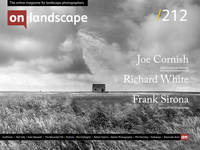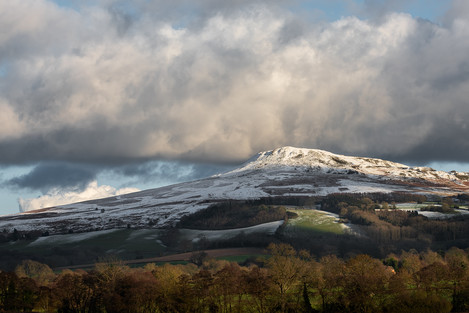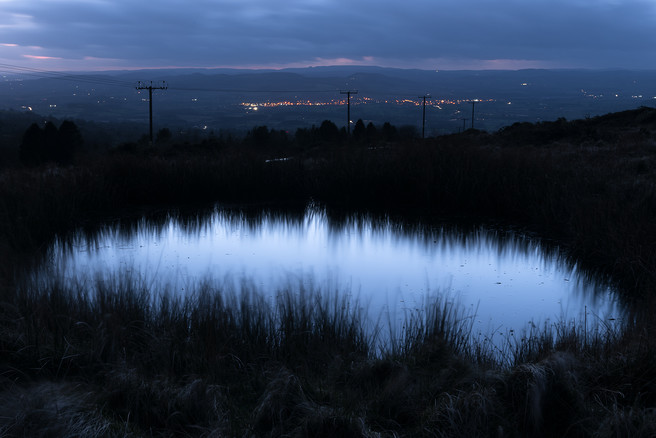Scarred, used, abused, and abandoned

Kate Maxwell
I am currently based in the Welsh Marches, surrounded by open hills and farmland. I have always enjoyed photography, but bought my first digital camera as a sketching tool for the paintings I was making at the time, and joined a local camera club to improve my skills. I became a “proper” photographer when asked to supply images for a local estate agent. When The Photo Space gallery opened in Ludlow, I was lucky enough to win its first competition for local photographers, leading to a solo exhibition. I am never happier than when wandering about outdoors with a camera to hand.
Titterstone Clee Hill is an iconic and much-loved feature of South Shropshire, looming above the medieval market town of Ludlow. On most days I see it from the end of my road. It varies in colour, from Alizarin purple, to Prussian blue, through Viridian green or even soap powder white. Sometimes it wears a cloud hat. At others, it simply vanishes.
But at close view, it is no great beauty. Scarred, used, abused, and abandoned, it bears the marks of thousands of years of human exploitation. Quarry ruins litter its scarred face, modern communications towers dominate the skyline, and a still active stone quarry delves deep into the core. Ragged sheep graze the tufted, boggy, rock strewn common-land, while peregrine falcons roost on the old quarry walls, enjoying a fine view of the tamed and fertile agricultural landscapes of the midland counties. The place is a modern wilderness, a rare thing in this crowded and manicured country, where nearly every inch is managed for profit or pleasure.
The idea of making this ramshackle hill the subject of
The first day of the conference was book-ended by two equally inspiring but antithetical speakers: Charlie Waite, celebrating the aesthetic of beauty in the landscape, and Paul Hill, challenging us to avoid cliché, idealisation and commodification, and instead to look closely at the world immediately around us.
This led me to question my own motivations for photographing the landscape – and a project based in my local area seemed a good place to start. The next question was, how to go about it? What’s the difference between a number of pictures of the same place taken at different times (I already had plenty of those), and a project yielding a body of work? I decided it must have something to do with narrative, and a full portrait of a place, up close and intimate, warts and all, as well as the bigger picture.
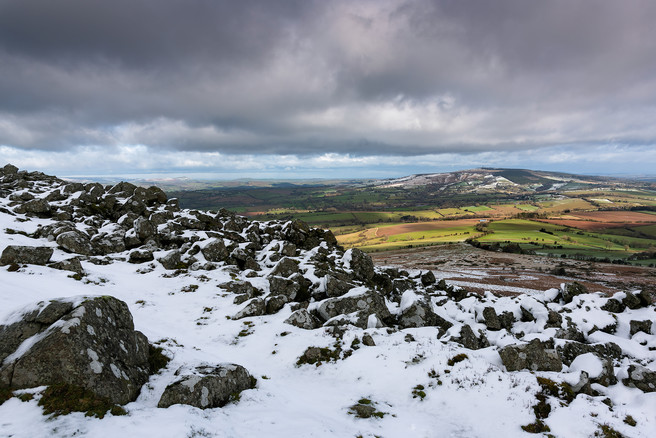
Looking towards Brown Clee (Shropshire’s highest point) over the collapsed Bronze Age hillfort wall.
The hill has been photographed in the past, most notably by Simon Denison, in his 2005 book, Quarry Land: Impermanent Landscapes of the Clee Hills. His gritty monochrome images depict the squalor and decay of the post-industrial landscape.
I wanted to take a different approach, one that reflects my personal and emotional connection to the hill I have lived beneath and wandered over for a decade. Like many local people, I have a deep and perhaps romantic attachment to this wasteland, with its dead signage and windblown relics, its jaunty terraced houses perched on the slopes, its tremendous 360-degree views over seven counties, and its sunset view over the Welsh Marches. It has an unconventional beauty, often enhanced by extraordinary light and weather. I decided to use colour, as for me the hues of the hill in its varied seasonal dress are part of its character.
There is an alluring charm to the rough-edged ugliness and worn out neglect being overcome slowly by natural forces. A snow bunting visited this year on its way home to the Arctic, and if you are lucky you will hear curlew, lapwing and cuckoo in spring. The wounds inflicted by humans are gradually healing as weather and vegetation soften the scars. The haunting dereliction has so far escaped sanitisation and idealisation by the heritage industry. There is no visitor centre, no toilet block, nothing to stop people falling off the edges of spoil tips or into flooded mine shafts, from dumping their MOT failures in the pits, or driving 4x4s up the near vertical slopes. Colourful graffiti covers many of the ruined quarry buildings, and even the millennium heritage signs are weathering to illegibility. There have been attempts to prevent further degradation and vandalism, as these early concrete structures are treasured by industrial historians, and the area is part of an AONB, but at present, there is little active preservation.
I began the project by looking into the history. A visit to the local library led to the discovery of old maps, and retired schoolteacher Alf Jenkins’ book Titterstone Clee Hills: Everyday Life, Industrial History and Dialect. Jenkins grew up in Dhustone, a village built near the summit in the nineteenth century for the quarry workers, where his father was publican and undertaker. In 1900, two thousand people were employed in the mines and quarries of the Clee Hills. The hardness of the dhustone, a black volcanic rock, was valued for infrastructure building in the late Victorian age, including Cardiff Docks, and into the 20th century as the motor car demanded smoother, harder roads.
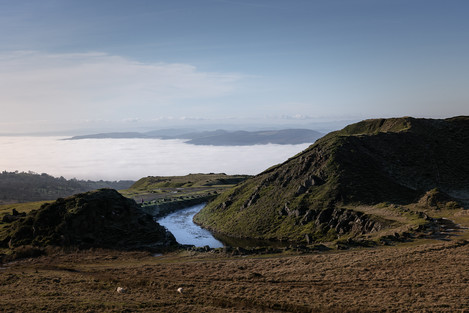
Above the clouds: cloud inversions are a local feature, here viewed from the abandoned stone quarry at the summit.
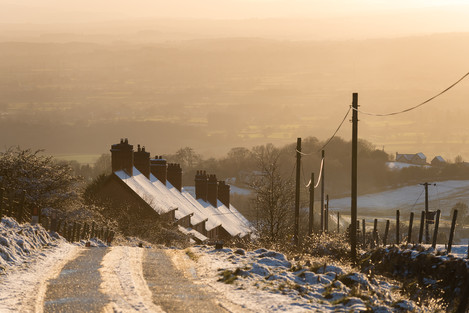
Dhustone village: terraced housing, unusual for rural areas, built in the 19th century for quarry workers.
The exploitation of the hill’s resources started long before the quarries however. Some of the bell pits, sunk into the shallow coal seams, are hundreds of years old. The Clee Hills (Brown Clee is Titterstone’s slightly taller sister seven miles north) are even drawn and named on the Hereford Mappa Mundi of c1300.
I decided to explore all the structures, from stone to concrete, which litter the hill today. The challenge was to make these old remnants interesting photographically – weather conditions and light are key here. Many of them are plain ugly or just a pile of rubble in the cold light of day, yet when transformed by light or exceptional conditions they evoke memory, mood and myth.
Much of the project has been spent fighting an internal battle between making pictorial versus illustrative images – do I try to make pretty pictures, or do I try to tell the story of the hill in pictures, which includes its bleaker aspects?
What I have learned so far is that there is much to be said for being able to visit, time and again, the same location, to look beyond the obvious, and to attempt to create interesting images from what is not obviously photogenic material. The closer I look the more I see, and I now have a list of images that need to be made at certain times of the year or in particular conditions to improve on what I have already banked. Many of the images work best in pairs or groups, rather than as one offs, so I visualise the project eventually taking the form of a book.
For the moment, Covid19 has brought explorations to a halt. I hope that by early summer it might be possible to venture out again to capture the impressive swathes of foxgloves that blanket the backside of the hill. New seasons always yield new images to continue the story.
A selection of images from the project are scheduled to be exhibited at The Photo Space Gallery in Ludlow, post-pandemic.
- Titterstone Clee receiving a dollop of snow
- Looking towards Brown Clee (Shropshire’s highest point) over the collapsed Bronze Age hillfort wall.
- Above the clouds: cloud inversions are a local feature, here viewed from the abandoned stone quarry at the summit.
- Dhustone village: terraced housing, unusual for rural areas, built in the 19th century for quarry workers.
- Disused mineshafts pockmark the hill overlooking Ludlow.
- Crumbling quarry buildings attract graffiti artists.
- Is anyone there? Modern communications towers track aircraft and rainfall.
- Death dance: remains of a small-holding which was still occupied a century ago.
- The valley below: a self-seeded hawthorn grows from a derelict “squatter” wall.
- Misty morning.

